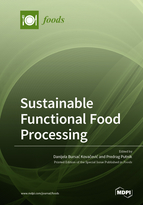Sustainable Functional Food Processing
A special issue of Foods (ISSN 2304-8158). This special issue belongs to the section "Food Engineering and Technology".
Deadline for manuscript submissions: closed (28 February 2021) | Viewed by 137385
Special Issue Editors
Interests: 3D food printing; non-thermal processing; green extraction; functional food; food chemistry
Special Issues, Collections and Topics in MDPI journals
Interests: general statistics; research methodology; experimental design; mathematical modeling; multivariate analysis; novel food processing and extraction technologies
Special Issues, Collections and Topics in MDPI journals
Special Issue Information
Dear Colleagues,
Functional nutrition has become one of the main directions for a healthy lifestyle and sustainable food production due to its promising positive influence on health and its association with the use of raw materials of natural origins. Hence, it has attracted great interest from both consumers and manufacturers concerned with human wellbeing and sustainable economic growth. Not surprisingly, the functional sector has become an increasingly lucrative segment of the food industry with a fast-growing market due to the new sociodemographic trends (e.g., longer life expectancy, promotion of healthy lifestyles, better health care, etc.). For instance, functional juices that are made from indigenous fruits (which, economically, are insufficiently explored) represent an interesting niche, providing all the above-mentioned characteristics to satisfy the interests of various food markets. Here, the focus is placed on biologically active compounds (BACs) and probiotics that are responsible for numerous positive effects of functional foods on health. Unfortunately, the majority of BACs are thermolabile, which is especially important for food production that still employs classical heat treatments (e.g., pasteurization). As previously documented, this will lead to food degradation and negatively affect the quality of the final product. To prevent such negative effects of the production process, scientist and engineers have concentrated their efforts on designing economical and environmentally acceptable technologies that are able to preserve food nutritional and sensory quality and microbiological stability during functional food processing. Such approaches are based on low energy consumption and on the use of low-impact processing and “hurdle technology” that combines advanced and conventional food technologies (e.g., high-power ultrasound (HPU), pulse electric field (PEF), etc.). Food design is important for consumer sensory appeal and economic success; hence, technologies such as 3D food printing can be particularly useful in food production.
This Special Issue of Foods will address the topics relevant to sustainable functional food production, functional fruit juices, biologically active compounds (BACs), hurdle technology, advanced food processing, 3D food printing, and authentic fruits.
Assoc. Prof. Dr. Danijela Bursać Kovačević
Dr. Predrag Putnik
Guest Editors
Manuscript Submission Information
Manuscripts should be submitted online at www.mdpi.com by registering and logging in to this website. Once you are registered, click here to go to the submission form. Manuscripts can be submitted until the deadline. All submissions that pass pre-check are peer-reviewed. Accepted papers will be published continuously in the journal (as soon as accepted) and will be listed together on the special issue website. Research articles, review articles as well as short communications are invited. For planned papers, a title and short abstract (about 100 words) can be sent to the Editorial Office for announcement on this website.
Submitted manuscripts should not have been published previously, nor be under consideration for publication elsewhere (except conference proceedings papers). All manuscripts are thoroughly refereed through a single-blind peer-review process. A guide for authors and other relevant information for submission of manuscripts is available on the Instructions for Authors page. Foods is an international peer-reviewed open access semimonthly journal published by MDPI.
Please visit the Instructions for Authors page before submitting a manuscript. The Article Processing Charge (APC) for publication in this open access journal is 2900 CHF (Swiss Francs). Submitted papers should be well formatted and use good English. Authors may use MDPI's English editing service prior to publication or during author revisions.
Keywords
- sustainable functional food production
- functional fruit juices
- biologically active compounds (BACs)
- hurdle technology
- advanced food processing
- 3D food printing
- authentic fruits








